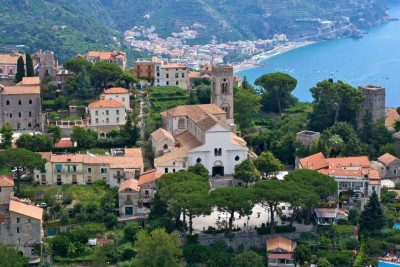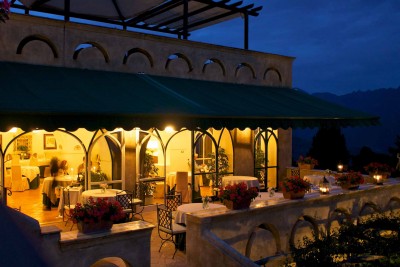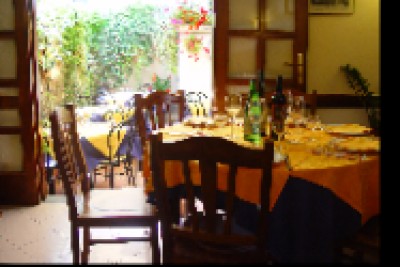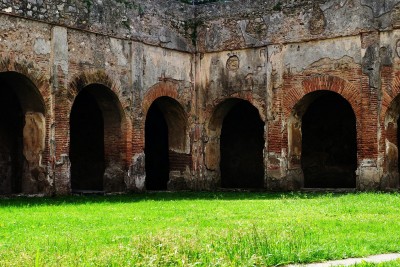Our Insider Guide to Ravello
Literary figures have been attracted to this town on the Amalfi Coast since Boccaccio visited it in the 13th century




Among the most famous vacation spots not only on the Amalfi Coast but in all of southern Italy, Ravello is nestled in the mountains between the valleys of the Dragon and the Regina streams.
Ravello, besides being a small jewel in and of itself, is a town of contrasts between the mountainous setting and the sea and the melancholy of the medieval palaces and the explosive vitality of their gardens.
The history of Ravello is connected to the glorious history of the Maritime Republic of Amalfi.
The first historically documented evidence of the town’s existence dates back to the 9th century, when it was recorded as a subject of Amalfi. Incorporated into the Duchy of Amalfi, it followed that town’s fortunes.
In 1137 Bernardo da Chiaravalle described it as "ancient, well-fortified and impregnable, as well as being opulent it is so beautiful that it can easily be numbered among the first and most noble cities."
Under the Normans, and even more their successors, the Anjou dinasty, Ravello kept growing in prosperity. In the 13th century, which was the period of greatest affluence, along with Scala, Ravello had 36,000 inhabitants.
The clearest testimony to the wealth of that era, is offered by the numerous civil and religious buildings built in Arab-Sicilian style that was introduced to the area by the wealthy merchant families who had commercial relations with Sicily, North Africa, Spain and the Middle East.The town prospered, thanks in particular to the flourishing wool-spinning mill, known then as the "Celendra," that was given to Bishop Giovanni Allegri by King Charles II of Anjou in 1292, to stimulate trade, especially with the Arabs and Byzantines.
After losing its prosperous economy, in the 17th century, Ravello was left with an incomparable position overlooking the Mediterranean Sea and architectural and artistic marvels built during the centuries of splendor.
The Duomo (#1 on the map), or Cathedral of Ravello, which stands on a high podium in piazza del Vescovado, is dedicated to S.Pantaleone and was founded in 1086 or 1087 by the first bishop of Ravello.
The bell tower, at the bottom of the right side of the church, was built in the 13th century.

Rebuilt in its present form in the 12th century, the Duomo was remodeled in 1786, when the portico that preceded its simple façade was demolished (only four columns remain). The lintels of the three doors are made of marble frames. In the middle is the precious bronze door of Barisano da Trani.
 The door is divided into 54 panels (one of them has the date, 1179) depicting saints, stories of the Passion and two masks.
The door is divided into 54 panels (one of them has the date, 1179) depicting saints, stories of the Passion and two masks.
The interior, with three naves divided by ancient columns and pillars, has been completely changed in a restoration completed in the 1970’s which suppressed the vaults and stuccoes, (a few traces are left in the transept).

To the right of the entrance, at the bottom on the inner wall of the facade, there are traces of ancient frescoes.
In the middle of the left nave, is the ambo, built in 1130 by the bishop of Ravello.

It is significant both for its Byzantine origin and for being the sole example of such style in all of southern Italy. It is decorated with 13th century mosaics depicting the death and resurrection of Christ. It faces a richly decorated pulpit that bears inscriptions with the name of the artist (Niccolò di Bartolomeo) and the date: 1272.
The marble case is decorated with rectangular marble columns, mosaics and elegant friezes and is supported by six spiral columns, also decorated with mosaics, and the roaring of young lions at the base.

 The mosaics are mostly made with ceramic tiles that were imported from Syria in the 13th century.
The mosaics are mostly made with ceramic tiles that were imported from Syria in the 13th century.

From the right transept you enter into the Sacristy, where there is a painting from the beginning of the 14th century representing a Madonna with Child, Saint Sebastiana and Mary Magdalene; another painting with the Archangel Michael, vestments from the 17th to the 19th century and a collection of scrolls.
In the Cripta del Museo della Cattedrale, or Crypt of the Museum of the Cathedral there are carvings and jewelery from various eras, Roman sarcophagi, 13th and 14th century tombstones, and various fragments decorated with 12th century mosaics.
On the right of the cathedral, a square tower marks the entrance to the complex of Villa Rufolo (#2, open daily 9am-8pm, tel:(+39) 089 857657, website).

Built in the 13th and 14th centuries, it was repeatedly refurbished in the following centuries.The villa, built on a terrace overlooking the bay, was erected in the second half of the 14th century by the Rufolos, the richest family of Ravello ( a Landulf Rufolo is remembered by Boccaccio in his "Decameron"), who then passed it along to the the Confalones and then the D’Afflittos. In 1851 it was bought by the Scotsman Francis Neville Reid, who restored it.
A pointed arch leads to the vestibule of the Tower (early 14th century), which is decorated with interlaced arches in the ceiling and on the walls, and four limestone statues (on the corners).
The path leading to the front of the villa is shaded by large cypress trees and creepers. To the right is the square courtyard. Similar to a cloister, it has two orders of loggias on columns and rich, polychromous decorations.


Around the villa lies the garden, full of exotic plants, pines trees and cypresses. A wonderful backdrop to the romantic ruins it inspired Richard Wagner to think of the magic garden of Klingsor in "Parsifal".

From piazza del Vescovado, to the right of Villa Rufolo, one can take via San Francesco, which after a arch moves uphill with steps toward the church of the same name (rebuilt in the 18th century).
Continuing on via Santa Chiara, which offers a beautiful view of the rising mountains around Ravello, one arrives at another church, preceded by a small porch. Already in existence in the 13th century but rebuilt in 18th, the Monastero e Chiesa di Santa Chiara (#3) has three naves with ancient columns and an 18th century maiolica tile floor. The adjoining monastery was founded in 1333.

Santa Chiara
Past Santa Chiara, a staircase to the right leads to Villa Cimbrone (#4, open daily 9am-8pm in the Summer, 9am to sunset the rest of the year, tel +39 089 858072).
 The Belvedere Cimbrone on the most prominent point of the spur where Ravello was built, offers a spectacular view from Amalfi to the plain of Paestum.
The Belvedere Cimbrone on the most prominent point of the spur where Ravello was built, offers a spectacular view from Amalfi to the plain of Paestum.
CELEBRITIES IN RAVELLO
In the spring of 1880, Richard Wagner arrived at Villa Rufolo, in Ravello, accompanied by his stage designer, the painter Joukovsky. At that time, the great German musician was working on Parsifal. In Ravello Wagner found both inspiration for the scenography of Act 2 of Parsifal and ideas for improving the whole musical architecture of his ultimate masterpiece.
Other musical giants inspired here were Arturo Toscanini, Bruno Walter, Leonard Bernstein and Mstilav Rostropovich.
Ravello has also hosted artists such as the Spanish painter Mirò, the Dutch artist Mauritius Cornelius Escher and, at the beginning of the 19th century, Turner, the English engraver and watercolorist.
Literary figures have been attracted to the town since Boccaccio visited it in the 13th century and called it one of "the most delightful place in Italy".
The protagonist of one of the loveliest tales of the Decameron, Landolfo Rufolo, is Ravellian.
Forster, the famous author of Room with a View, sketches Ravellian scenes out in a short story. Ravello also had the good fortune to repeatedly play host to other English writers, including Virginia Woolf, author of To the Lighthouse.
David Herbert Lawrence wrote numerous chapters of Lady Chatterley's Lover in Ravello, and André Gide set a part of his novel, The Immoralist here.
Others include Paul Valéry, Graham Greene, Tennessee Williams, Rafael Alberti and, of course, Gore Vidal, who lived in Ravello for decades.
Scala
Just outside Ravello, in a beautiful position on the right bank of the River Dragon, is the small town of Scala which already existed in the early Christian era as attested to by the many third and 4th century tombs found there.
The Cattedrale di San Lorenzo (#5) is first mentioned in a document from 1169.

On the facade, which has a simple 18th century decoration and is preceded by two bare columns, are the beautiful Romanesque portal and a sepulchral slab of the Angevin era.
The interior, with three wide naves, has 18th century stucco decorations, and a coffered ceiling dated 1746.
The safe in the last pillar on the right preserves a bishop's miter with enamel decorations from the 13th and 14th centuries, donated by Charles of Anjou, and a silver chalice with enamel decorations dated 1332.
From the right aisle, a staircase leads to the Crypt, one of the most interesting structures in the Amalfi Coast. It is divided into two aisles by four tall bare columns that hold vaults.
Above the main altar are 13th century wooden sculptures (a Crucifix, the Virgin and St. John).
From the little square to the right of the church there is a beautiful view of Ravello.
Scala, like other towns on the Amalfi Coast, has a polycentric structure, made up of small neighborhoods stretching from North to South and defended by two castles.
Outside Scala
The small borgo of Campidoglio (the Capitol), with two small churches offers a beautiful view of Ravello and the sea.
About a thousand yards from Scala is Minuto, the site of the original cathedral.

The Chiesa di Santa Annunziata (#6) visit on request), built at the end of the 13th century, is preceded by a portico with three pointed arches and three portals. In the interior, with three naves divided by ten ancient columns of oriental granite, there are a marble eagle (first half of the 14th century), a 13th/14th century baptismal font and, behind the altar, a 13th century urn.
The crypt is decorated with 12th century frescoes of Christ between Saint John the Baptist and the prophets Daniel and David; Life of Mary; Legend of St. Nicholas.
From the square in front of the church and to the south, one can see the ruins of the Basilica di Sant'Eustacchio (#7), or Church of St. Eustace.



Simply judging from what is left of it, this basilica must have been extraordinary, and it is absolutely worth visiting even today.
Near Scala is the village of Pontone, known by the name of Scalella until the middle of the 12th century. In its main square, where the roads toward Minuto, Amalfi and Atrani converge, one finds the Chiesa di San Giovanni Battista (#8), or Church of St. John the Baptist.

For printing our Ravello Guide (facing pages) you can download the PDF by clicking HERE
For offline reading on your smartphone or tablet, you can download the PDF of our Ravello Guide (single page) by clicking HERE
If you have an Android OS, you will find it in your Download app.
If you have an iPhone or an iPad, open and save it in iBook (free app).
The Ravello Music Festival
Ravello becomes the favorite destination for music lovers thanks to the Ravello Concert Society. You can find the program HERE You can download the brochure HERE You can book tickets online HERE
Watch a video





